A very effective pure sine wave inverter circuit can be made using the IC 4047 and a couple IC 555 together with a few other passive components. I have explained the details below.
The Circuit Concept
In the previous post I explained the main specifications and datasheet of the IC 4047 where I have explained how the IC could be configured into a simple inverter circuit without involving any external oscillator circuit.
In this article we carry on the design a little ahead and learn how it can be enhanced into a pure sine wave inverter circuit using a couple of additional ICs 555 along with the existing IC 4047.
The IC 4047 section remains basically the same and is configured in its normal free running multivibrator mode with its output extended with the mosfet/transformer stage for the required 12V to the AC mains conversion.
How the IC 4047 Functions
The IC 4047 generates the usual square waves to the connected mosfets creating a mains output at the secondary of the transformer which is also in the form of square wave AC.
The integration of the two 555 IC to the above stage completely transforms the output into a pure sine wave AC. The following explanation reveals the secret behind the IC555 functioning for the above.
Referring to the below shown IC 4047 pure sine wave inverer circuit (designed by me), we can see two identical IC 555 stages, wherein the left section functions as a current controlled sawtooth generator while the right hand side section as a current controlled PWM generator.
The triggering of both the 555 ICs are derived from the oscillator output readily available across pin#13 of IC 4047. This frequency would be 100Hz if the inverter is intended for 50Hz operations, and 120Hz for 60Hz applications.
Using IC 555 for the PWM Generation
The left 555 section generates a constant sawtooth wave across its capacitor which is fed to the modulating input of the IC2 555 where this sawtooth signal is compared with the high frequency signal from pin3 of IC1 555 creating the required pure sine wave equivalent PWM at pin#3 of 555 IC2.
The above PWM is directly applied to the gates of the mosfets. so that the square pulses here generated through pin10/11 of IC4047 gets chopped and "carved" as per the applied PWMs.
The resulting output to the transformer also causes a pure sine wave to be stepped up at the mains AC secondary output of the transformer.
The formula for calculating R1, C1 is given in this article which also tells us about the pinout details of the IC 4047
For the NE555 stage C may be selected near 1uF and R as 1K.

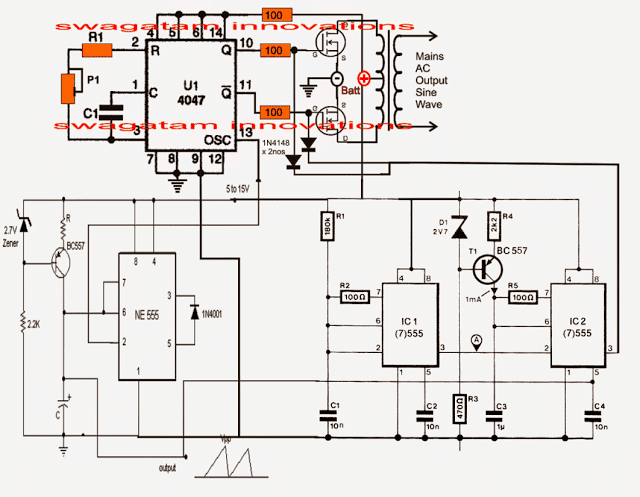
Assumed output waveform
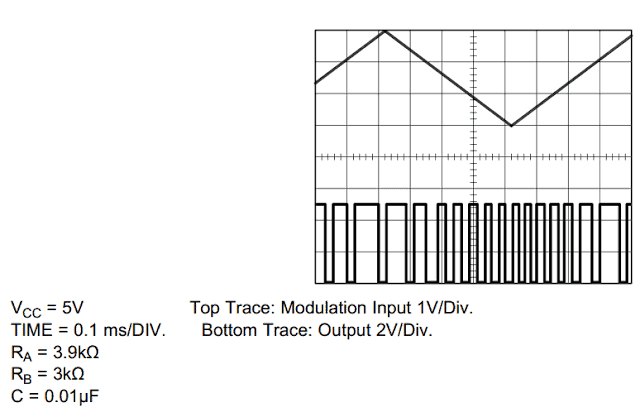
More info on how to use IC 555 for generating PWM
An RMS adjustment could be added to the above design by introducing a pot voltage divider network across pin5 and the triangle source input, as shown below, the design also includes buffer transistors for improving mosfet behavior
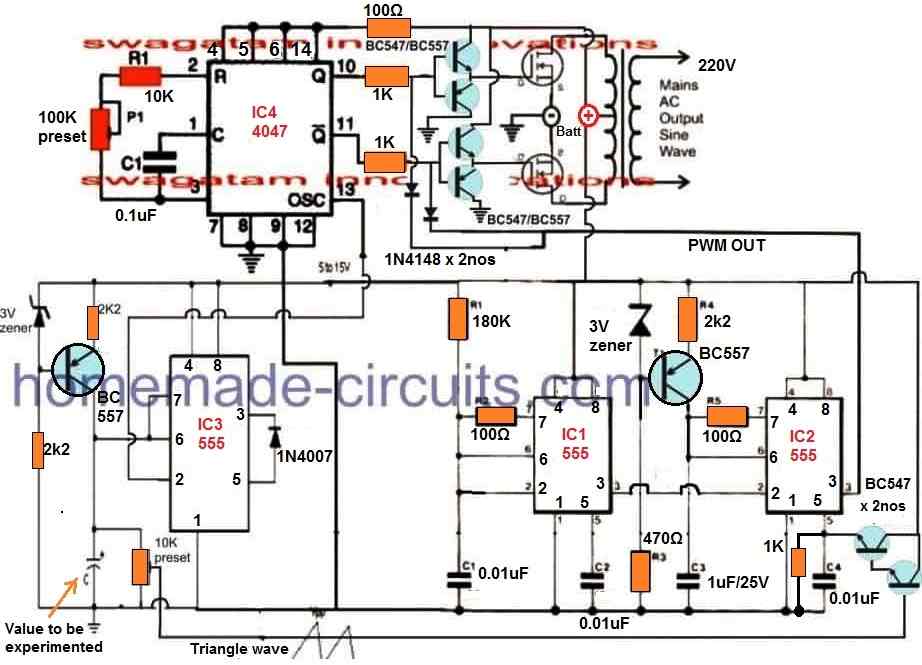
The above pure sine wave inverter design was successfully tested by Mr. Arun Dev, who is one of the avid readers of this blog and an intense electronic hobbyist. The following images sent by him prove his efforts for the same.


More Feedback
Inspiring response received from Mr. Arun regarding the above IC 4047 inverter results:
After completing this circuit, the result was amazing. I got full wattage by the 100 W bulb. Couldn't believe my eyes.
The only difference i had made in this design was replacing the 180 K in the second 555 with a 220 K pot to adjust the frequencies accurately.
This time the result was fruitful in all respects... On adjusting the pot, i could get a non disturbing non flickering full wattage glow in the bulb, also the 230/15 V transformer connected as the load gave a frequency in between 50 and 60 ( say 52 Hz ).
The pot was adjusted gently to get a high frequency ( say 2 Khz ) output from pin#3 of second ic 555. The CD4047 section better calibrated to get 52 Hz at the two output terminals....
Also I am facing a simple problem. I have used IRF3205 mosfets at the output stage. I forgot to connect the safety diodes across the drain terminals of each mosfets...
So when I had tried connecting an another load ( say table fan ) in parallel to the given load ( 100 W bulb ), the glow of the bulb also the speed of the fan was reduced a little and one of the MOSFET was blown due to the absence of the diode.
The above 4047 sine wave inverter circuit was also tried successfully by Mr. Daniel Adusie (biannz), who is a regular visitor of this blog, and a hardworking electronic enthusiast. Here are the images sent by him verifying the results:
Sawtooth Waveform Oscilloscope Output

Illuminating a 100 Watt Test Bulb

The following images show the modified waveforms at the output of the transformer as captured by Mr. Daniel Adusie after connecting a 0.22uF/400V capacitor and a suitable load.
The waveforms are somewhat trapezoidal and are far better than a square wave which clearly shows the impressive effects of the PWM processing created by the IC555 stages.
The waveforms could be probably even further smoothened by adding an inductor along with the capacitor.
Showing an near Sinewave Oscilloscope Trace after PWM Filtration
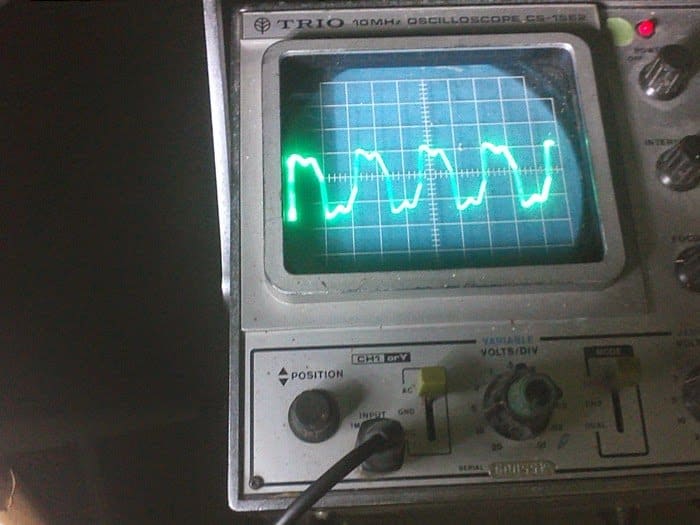
Interesting feedback received from Mr. Johnson Isaac who is one of the dedicated readers of this blog:
Good day
In your post, Pure Sine Wave Inverter using 4047, in the second I.c stage (ic.1) you used 100 ohms resistor in between pin 7 and 6.,
Is that correct? I use to think an astable multivibrator using 555 pin configuration should have the 100 ohms between pin 7 and 6. Also, the 180k variable between pin 8(+) and pin 7. Pls check the pin connection and correct me pls. Because it oscillate sometimes and it doesn't sometimes also. Thanks,
Isaac Johnson
Solving the Circuit Issue:
In my opinion, for a better response you can try connecting an additional 1k resistor across the 100 ohm outer end and pin6/2 of IC1
Johnson:
Thank you very much for your response. I actually constructed the inverter you gave in your blog and it worked.
Though I don't have an oscilloscope to observe the output waveform BUT I bet readers its a good one cos it operated a fluorescent tube lamp in which any modified or pwm inverter can't power on.
See the picture sir. But my challenge now is when I add load, the output flickers sometimes. But am happy its a sine wave.
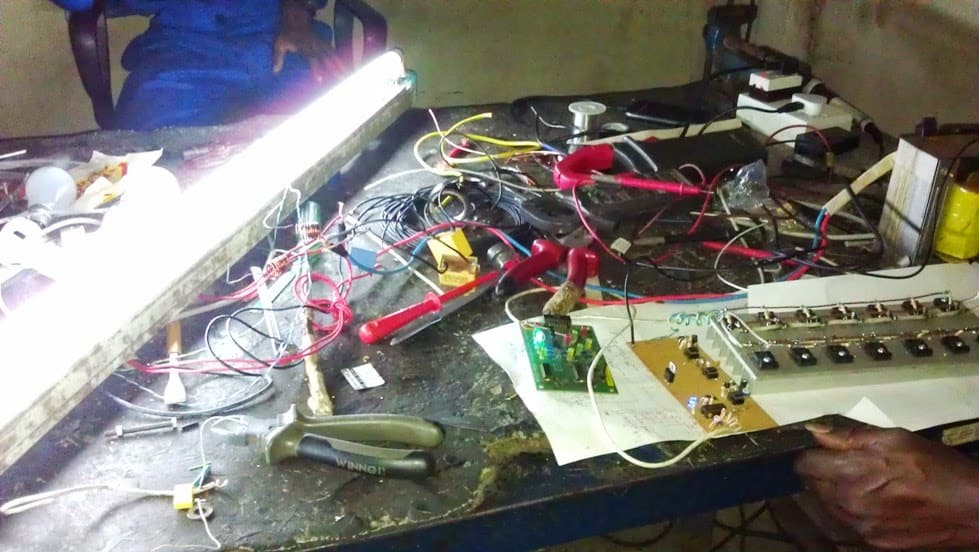
Video Test Waveform
Simplifying the above Concept
The above explained IC 4047 pure sine wave inverter can be actually simplified greatly by eliminating two IC 555 configurations from the design.
The basic idea is to produce a synchronized sine PWM output for chopping the MOSFET switching so that this SPWM waveform is replicated at the output of the transformer and is transformed into a pure sine waveform. The complete circuit diagram can be seen in the following diagram:
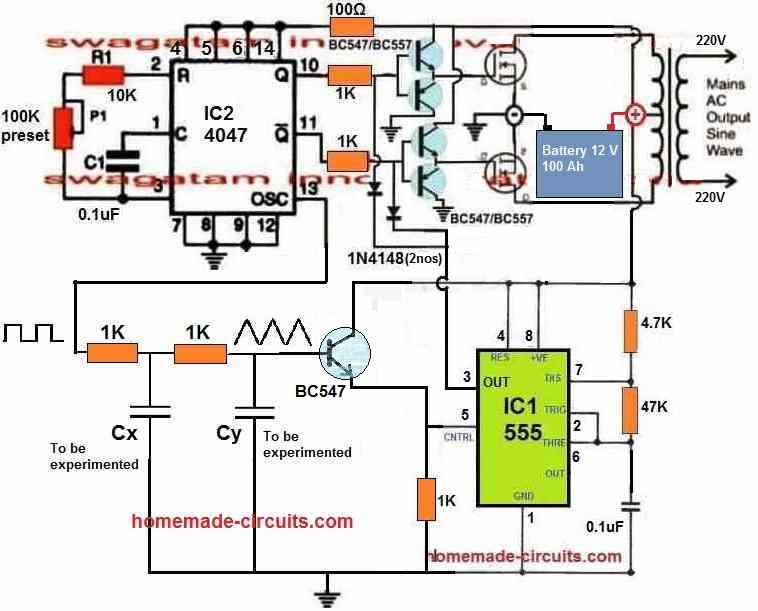
In this simplified design, we yet again exploit the pin#13 square wave output from the IC 4047 and convert it into triangle waves. This triangle wave is then used to modulate the PWM output of a IC 555 astable to create the required synchronized SPWM for chopping the MOSFET gates.
The capacitors Cx and Cy will need to be experimented a bit to create a proper triangle waves from the RC network output.
Remember, you will need an oscilloscope to check and confirm the various waveform discussed in the above diagram.
Another Simpler Looking Options
The following concept discuses a rather simpler method of modifying an ordinary square wave inverter using IC 4047 into a sine wave inverter through PWM technology. The idea was requested by Mr. Philip
Technical Specifications
I hope that i am not going to be a bother, but I need some advice with a PWM-controlled modified sine wave inverter I am designing so I want to seek your expert opinion.
This simple design is tentative, I haven't implemented it yet but I would like you to take a look at it and tell me what you think.
Also I want you to help answer some questions which I have not been able to find answers to.
I have taken the liberty of attaching an image of a quasi-block diagram of my tentative design for your consideration.
Please help me out. In the diagram, the IC CD4047 in the inverter is responsible for generating square wave pulses at 50Hz which will be used to alternately switch on MOSFETS Q1 and Q2.
The PWM circuit will be based on IC NE555 and its output will be applied to the gate of Q3 so that Q3 will provide the PWM. Besides this, I have two questions.
First, can I use square waves for the PWM pulses? Second, what is the relationship between PWM frequency and supply frequency? What PWM frequency should I use for a 50Hz inverter output?
I hope that this design is feasible, I think it is feasible, but I want your expert opinion before I commit scarce resources to implement the design.
Looking forward to hearing from you sir!
Sincerely, Philip
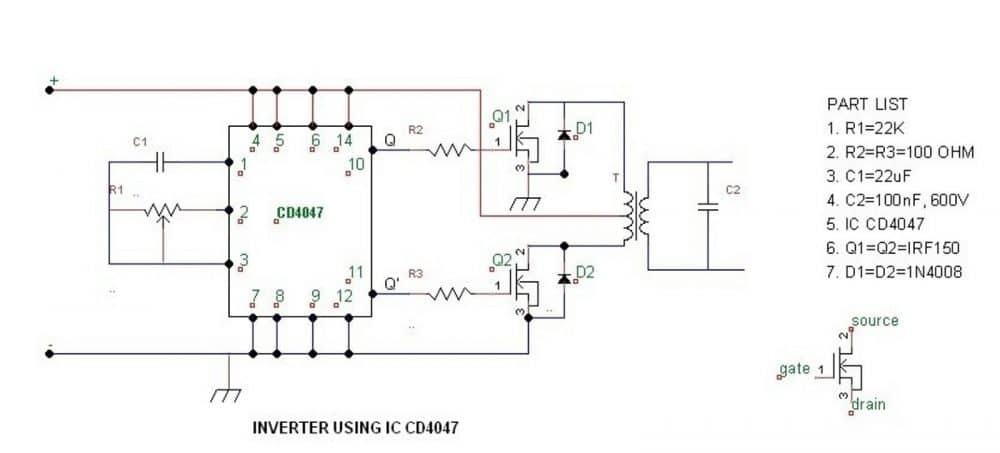
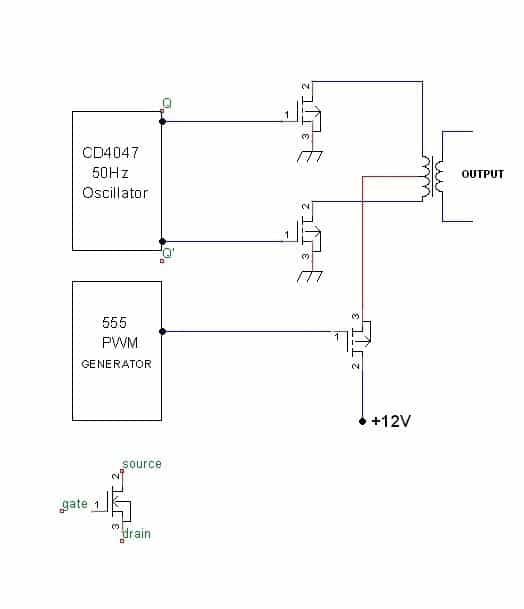
Solving the Circuit Request
The configuration shown in the second figure above would work only if the center tap mosfet drain/source pins are swapped and N-channel mosfets are used for the 4047 inverter oscillator output, as shown below:
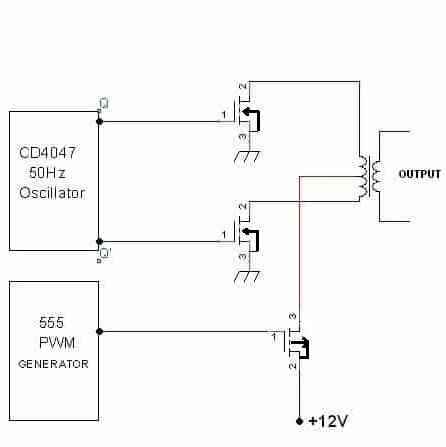
The PWM section should be built as I have explained in this article:
The PWM transforms the flat square waves into a modified square wave by chopping them into smaller calculated sections such that the overall RMS of the waveform becomes as close as possible to an actual sine counterpart, yet maintaining the peak level equal to the actual square wave input. The concept may be learned in details here:
However the above transformation does not help to eliminate the harmonics.
The PWM frequency will be always in the form of chopped square waves.
The PWM frequency is immaterial and may be of any high value, preferably in kHz.
How to Add Feedback Voltage Control to a 4047 IC Inverter
In this section we will discuss how to add an automatic feedback voltage control to a 4047 IC based inverter circuit.
If you don't want to read the whole explanation, you can watch the following video instead:
This type of feedback network is intended to ensure that the AC output voltage from the inverter never exceeds a predetermined safe value. For example, using this automatic feedback control, a 220 Volt inverter circuit output could be restricted to maximum 230V AC level, which may be safe for most 220 Volts appliances.
For a 120 Volt inverter system, this feedback network could be adjusted to restrict the output AC to a maximum of 115 Volts AC, which may be safe for most 110 Volt appliances.
How the Feedback Circuit Works
Now let's understand how the simple feedback network is designed to work, by referring to the following circuit diagram:
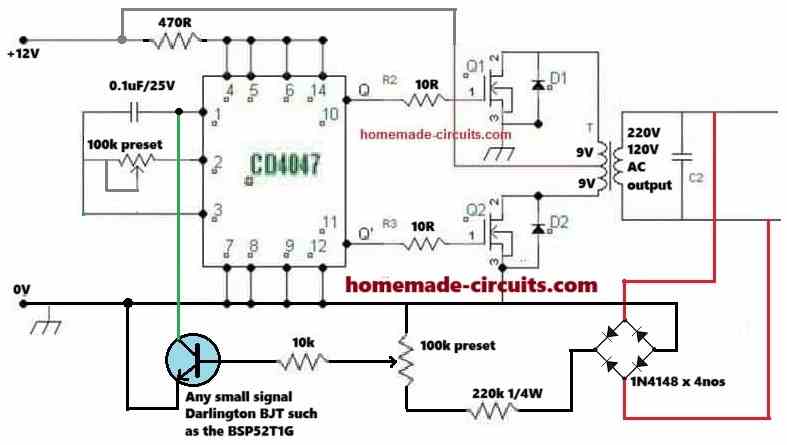
The mains AC voltage from the inverter transformer secondary is first converted to a DC voltage using a bridge rectifier.
This bridge rectifier is built using 4 numbers of 1N4148 diodes.
The DC 220 Volts output from the bridge rectifier is applied to an adjustable voltage divider network built using a 220 k resistor and a 100 k preset or trimpot.
The 100 k preset is carefully adjusted such that its central wiper terminal generates around 1.2 volts in response to an input AC voltage which is considered high, and needs to be restricted.
Let's say, the input AC needs to be restricted at around 270 Volts, then the 100 k preset may be adjusted so that its wiper terminal generates a proportional DC voltage level of 1.2 Volts.
We select a 1.2 Volt output because this is the equivalent DC level required to just switch ON the attached BJT device.
That means, whenever the inverter output AC voltage tries to exceed the 270 Volts mark, it causes the BJT to turn ON and become conductive.
When the BJT conducts, it starts grounding the CT pin of the IC 4047.
Since the RC network associated with the CT and the RT pinouts of the IC determines the output frequency and PWM, the grounding of the CT pin instantly causes the output PWM and frequency to nullify, which in turn causes the output AC voltage to dip.
When this happens, the feedback voltage to the BJT also drops proportionately until the BJT is turned off. In this situation the IC output PWM is restored back to its previous form, and if the output voltage continues to rise, it yet again activates the BJT via the feedback network, and this feedback on off cycle keeps repeating rapidly, ensuring that the output AC is not able to rise above the set threshold, which is 270 volts in our example.
This concludes our feedback control circuit explanation, now let's try to understand how this feedback circuit can be setup prior to integrating it with the inverter circuit.
How to Setup
The next diagram below shows the isolated feedback circuit, which can be set up by implementing the following steps, before interfacing it with your inverter circuit:
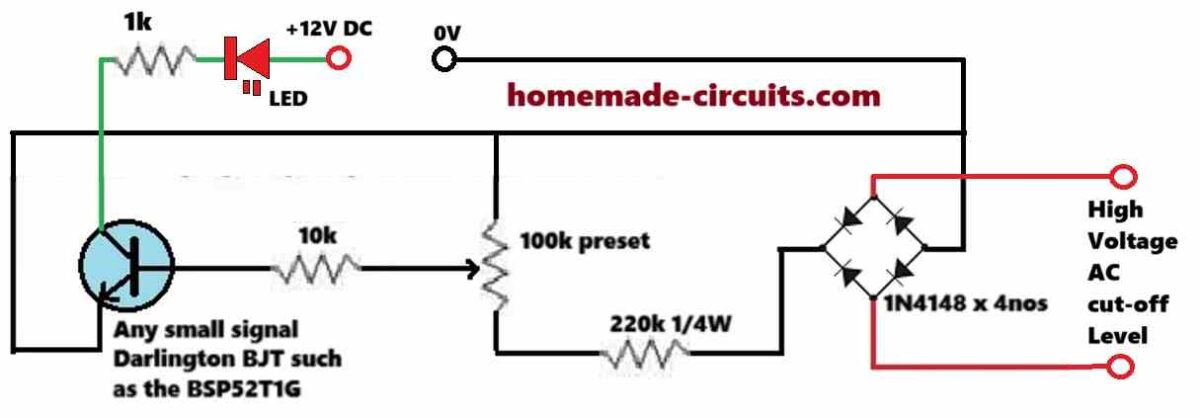
Initially keep the 100k preset's wiper arm fully towards the ground side of the DC supply.
Now, switch ON the 12 DC supply and then switch ON the AC supply to the bridge rectifier whose voltage level is around the desired high cut-off limit.
Next, slowly adjust the preset using a well insulated screw driver, until the LED just begins to illuminate.
To confirm the results, try varying the input AC voltage around the cut-off threshold and watch the LED turn on and off at the thresholds. Although the cut-off may not be too sharp, yet it will do the job of the intended output voltage control of the inverter quite well.
That's it! This simple procedure should be enough to complete the setting up of the feedback circuit.
After this, make sure to seal the preset adjustment with some super glue.
So, this concludes our explanation on a feedback circuit for the 4047 inverter.
Pseudo-sinusoidal IC 4047 Inverter Circuit
From a continuous source, battery, or vehicle alternator, it is possible to produce a 50 Hz voltage/pseudo-sinusoidal waveform, using this simple IC 4047 inverter circuit. The design is capable of operating many low-power devices that require a voltage of 220 V AC, typically supplied by the AC mains grid distribution network. The power of this module depends largely on the chosen transformer and, above all, on the continuous source's ability to supply the circuit without failure.
Working Principle of the circuit
Being able to power a device on the 220 V AC network when no mains AC power is available can be very convenient. We particularly think of campers, caravanners, fishermen, and motorists.
Although this simple setup does not provide a 100% clean sinusoidal wave, it can still satisfy many undemanding devices such as incandescent or fluorescent lighting, soldering irons, small motors, etc.
The power can reach up to 250 VA if the continuous source is strong enough and an adequate toroidal power transformer is chosen.
The power transistors are rated for 30 A, provided that a substantial heatsink is used.
We even suggest adding a small fan directly connected to the 220V output, which will prevent it from operating without a load.
Analysis of the Circuit Diagram
To obtain an alternating voltage from a DC source, the simplest solution is to use an inverted transformer: the low-voltage secondary winding has a center tap.
It is then sufficient to alternately supply power to the two windings to produce a symmetrical, but non-sinusoidal, variable voltage on the primary side if the low-voltage secondary winding is driven by a rectangular signal with steep edges.
Two complementary and opposite signals are required, and the CMOS integrated circuit with the reference 4047 is used to generate them, capable of either building an astable or monostable flip-flop.
The proposed diagram is shown in the figure below.
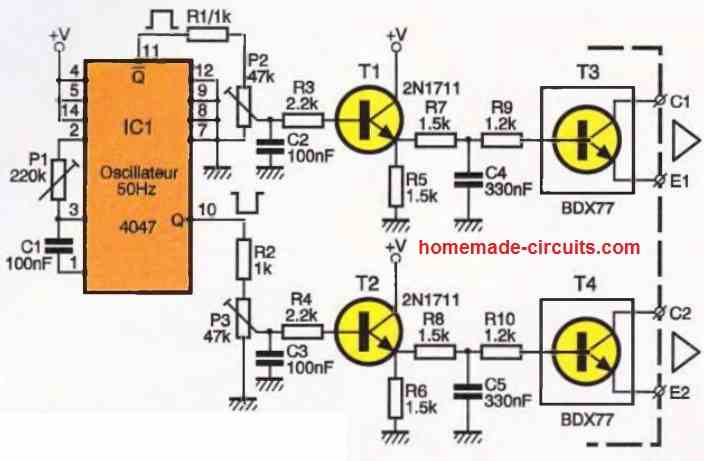
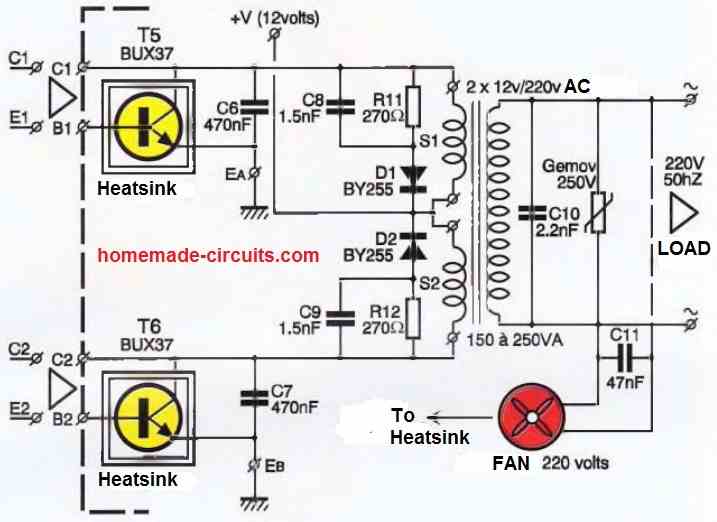
Of course, we will operate our circuit as an astable generator, ensuring a precise frequency of 50 Hz. This task is entrusted to components C1 and P1. Some pins of the IC1 circuit are connected to the ground or the positive supply, depending on our needs.
For more information, you will find an explanation in the appendix about the multiple possibilities of this practical little integrated circuit.
The symmetrical square voltages available at pins Q and Qdash (corresponding to terminals 10 and 11 of the circuit) are routed through resistors R1 and R2 to an adjustable element. Its role is to balance the amplitude of the two signals and facilitate the adjustment of the control module.
Note that the duty cycle will be exactly 50% by design. The sliders of elements P2 and P3 control the base of a 2N1711 transistor, which is responsible for driving the downstream power semiconductors.
Components R7, R9, C4, as well as R8, R16, and C5, form a coarse filter capable of smoothing out the signal angles to some extent.
This will allow us to create a "pseudo-sinusoidal" signal that will control the intermediate transistors T3 and T4 mounted on the small control board.
The BDX 77 models are rated for an emitter-collector voltage of 80V and a maximum peak current of 8A. They are delivered in a TO-220 package and will benefit from a heatsink.
The secondary windings of the transformer do have a common point connected to the positive pole of the power supply.
The other end of the coils will receive the ground through the power transistors T5 and T6, a model not much larger than the famous 2N3055 but with a maximum peak current of around 30A in this case.
It is the NPN bipolar model with the reference BUX 39.
Diodes D1 and D2 absorb the unavoidable breakdown current produced at each interruption of the inductive element, which is the transformer.
The primary of the transformer, a toroidal model in this case, delivers a 50 Hz AC voltage.
The component labeled Gemov (or varistor) is placed between the output pins to clamp excessive voltage surges that may occur.
Two wires can also be tapped from the output to operate a fan directly powered by 220V, which will provide airflow to cool the transistor-heatsink assembly.
It is important to ensure that the voltage of the continuous source does not drop too much or be completely depleted in the case of a lead-acid battery.
It goes without saying that the input DC current can reach considerable values if, for example, a power of 200VA is desired. It would be prudent to include a robust series fuse, similar to those found in a household installation.
Construction
The creation of two printed circuit boards is necessary: the first one, shown in the figure below, is designed for the components described in the control module.
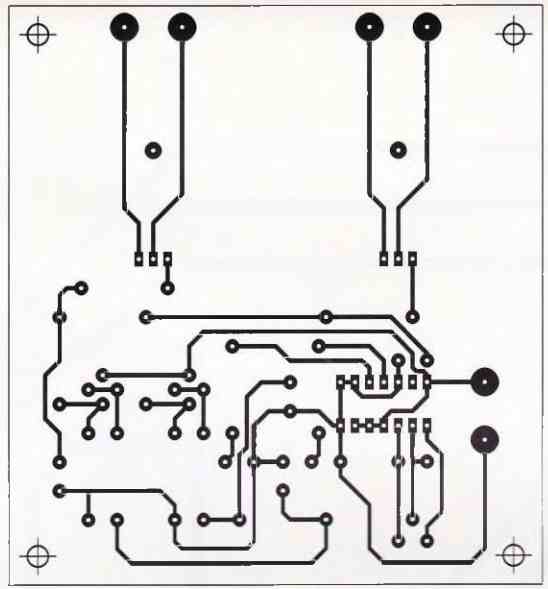
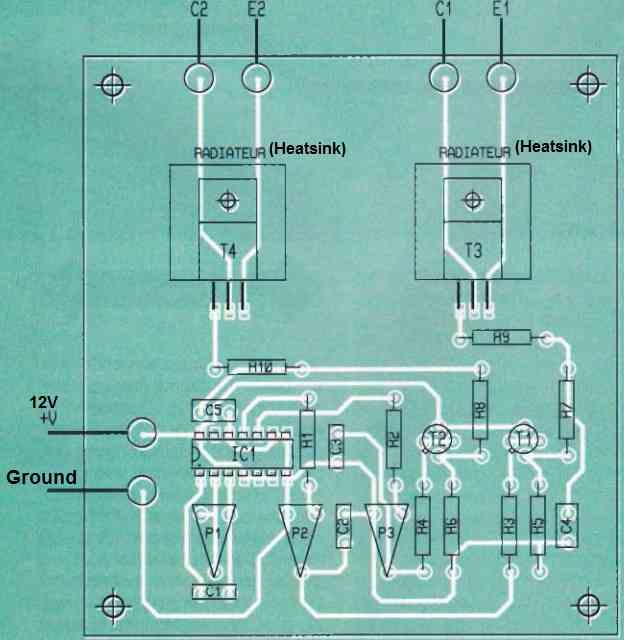
The layout is not very dense, but it is still recommended to use pre-sensitized copper-clad boards for reproduction.
After etching and rinsing, various drillings are carried out. Care must be taken to carefully mount transistors T3 and T4 on a small heatsink, which is directly attached to the epoxy board.
From this board, six wires will go to the significantly larger power module, and the track layout at a 1:1 scale can be found in the figure below.
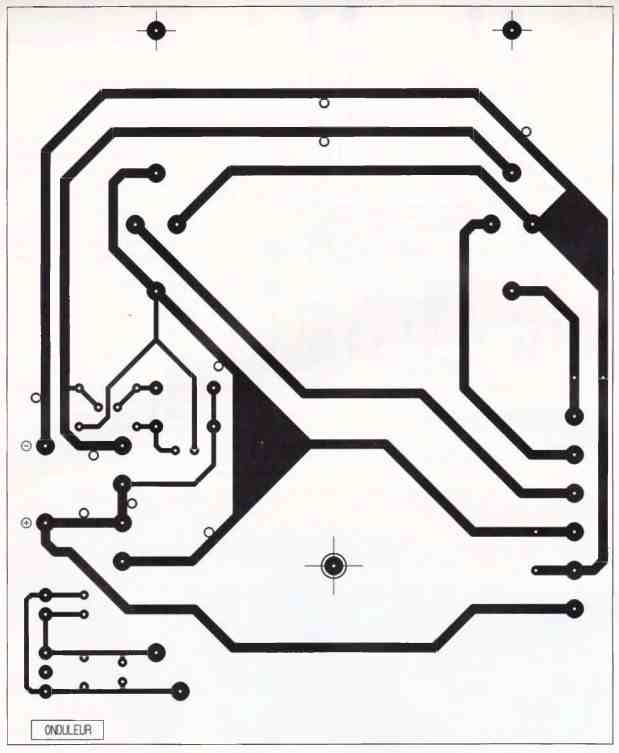
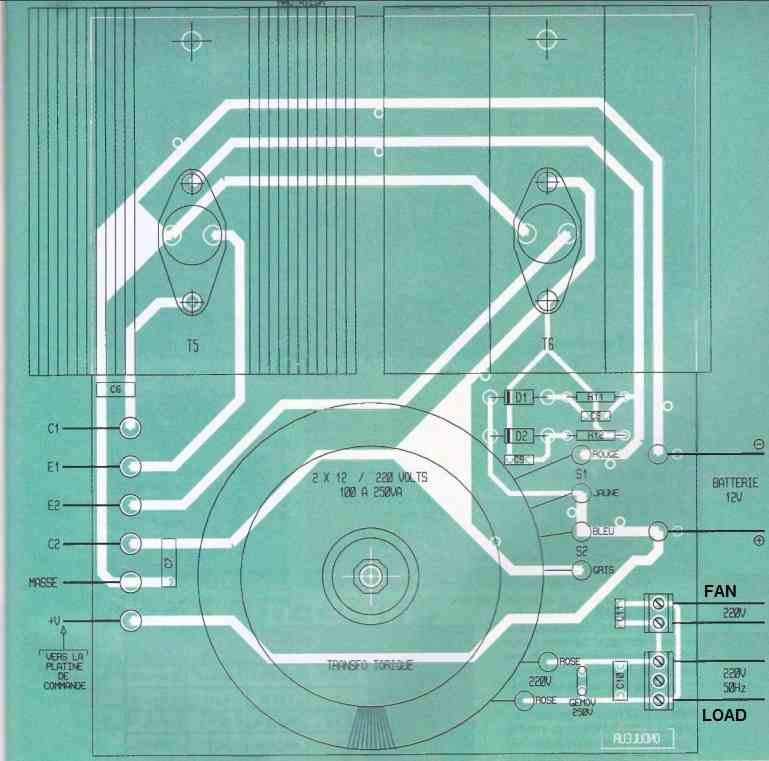
It should be noted that certain tracks on this simple IC 4047 inverter circuit board will carry high currents and require special treatment. We recommend soldering bare copper lengths, with a section of approximately 1.5 mm2, directly onto these tracks.
For example, electrician's copper wire with the insulation removed can be used. Care should also be taken to ensure all connections between the two boards, and in particular, to avoid reversing the wires.
The transformer has six wires, with the two thinnest wires corresponding to the primary, and therefore our 220V output.
It is important to properly identify the other windings before soldering them permanently. This assembly can be housed in a sturdy, adequately ventilated metal enclosure.
How to Setup
We leave it to you to complete this final step for this simple IC 4047 inverter circuit. After a thorough check, the frequency can be adjusted to 50 Hz under no-load conditions using the adjustable preset P1, if you have an oscilloscope or frequency meter.
Otherwise, simply set this element to the midpoint position. The other two adjustable components are set to obtain a symmetrical signal in amplitude.
Initial tests can be performed using a simple socket where different power lamps can be connected. For resistive or slightly inductive loads, there should be no serious issues.
Proceed with caution when testing devices that typically require a true sinusoidal voltage.

Hi
thanks for your help i have actually build this circuit the last one i.e. the fed to pin 9 of 4047 ic, i notice the frequency at pin 10/11 is not steady but i have steady frequency of 101 at pin of 13/2 of 4047 and the first ne555 also i have steady 101 at pin 5 of the third ne555 and steady 2.5khz at pin 2 of ic2 though i tested without load could it be the reason of the fluctuations at pin 10/11
I am not exactly sure about the issue, I think you should try the third circuit from top which has BJT buffers, and the PWM is fed to the base of these buffers instead of the mosfets. This configuration can be expected to be much reliable than the others.
Thanks for this design
I build the above circuit with SG3524 IC, I connect the 555 based output to pin 3 of IC 3524 and it works fine when I use it to power 100w bulb although I don't check to wave as I don't have instrument to do that
My problem now is when I connect the output from the third iC555 to pin 11 and 14 with 1N4148 as shown in the circuit above it doesn't work at all. So please where can I connect it to or I should leave it?
you will need to adjust the PWM for selecting the correct RMS value with the pot…..try the third circuit from top. You can check the RMS variations by a DC meter also at pin3 of the IC2
Sir, this project uses PWM high frequency is generated.
What type of transformer used: ferrite, siliceous iron (leaves EI).
If you work with siliceous iron that Gauss value (Bmax) is designed.
Thank you
iron core transformer is used for the above project
sir i have one doubt , transformer used in this circuit is,..15-0-15 secondary wind , so can we use,. 12-0-12 in stage of this
Nitesh,
can you show me where is it mentioned that the transformer is 15-0-15V??
yes you can use a 12-0-12V tranformer
sir what can i use capacitance value other than 0.68uf and it is a mylar caps or ceramaic. what ohms value should i set on a 22k potentiometer.
does all caps in ceramic or mylar?
ceramic and mylar both will work, but mylar could be more reliable than ceramic, due to its robust structure
22k will need to be set using a frequency meter at the output of the iC
well actually, that is a big problem sir..
i don't have that kind of equipment for testing the output frequency. thats why im asking u the right value of not mentioned components so that i can make it successfully.
sir i am having trouble for finding the ic4047 it was not available here. is there substitution or replacement for that ic. could i use ic 4017?
sir and what is the value for R and C in ic555(1)?
also what is the value of the two power transistor?
In that case you should not try this circuit because the circuit will require all kinds of measuring equipment for optimizing the various parameters…..also also an in-depth knowledge of electronics
Angelous, I'll advise you that you first learn all the basics of electronics, and only then attempt building any electronic circuit of this level
….4017 and 4047 are entirely different ICS, these cannot be interchanged…R and C will need to be determined using a frequency meter..
the two mosfets are IRF540
sir what should be the value diode use to protect againt back EMF?
Angelous, use a diode with amp rating equal to or more than the trafo amp rating
also i dn confuse for the components that is connected to pin 7 of ic2 which is rated of 1mA it is a diode? if so what ia the complete value it was not mention in your design it makea confusion.
that's just an arrow mark, not a component.
sir please give me the correct value for R1 that is connected to pin 2, P1 connected to pin3, and c1 connected to pin1 of ic 4047.
i am going to simulate this circuit.
Angelous, R1 can be a 1K resistor, P1 can be a 22k pot, and C1 can be a 0.68uF cap
Hi Mr Swagatam Majumdar! actually I constructed the inverter that you gave in your blog, my problem ,I have a different frequency output at pin 10 and pin 11.Why? Thank you
Hi Tojo, that's unlikely and strange, could be an IC problem or some other related fault.
try disconnecting the mosfets gates and then verify…if it corrects would indicate a faulty mosfet or PWM diode
Thank you for replying.
Thank you sir ,
Please sir can you design a solar tracker system.
Angelous, you can refer to the following post:
https://www.homemade-circuits.com/2011/12/how-to-build-dual-solar-tracker-system.html
Sir thanks for replying my questions, anothing thing if more power transistor are added to the above circuit is there are possibilities that the output wattage would increase too?
Is this inverter can power some electronic devices like for example TV, radio, loptop and etc. Without damaging it? Cause i have heard that modified sine wave inverter is not very well to run that kind of devices. However, in the positive side it very well to run the electrical devices such as light bulb and heater.
Hope you will answer my question.
Angelous, yes, adding more transistors will increase the output power proportionately, but that will also require the battery AH to be upgraded to higher levels.
a good quality modified sine wave can be used with almost all types of appliances safely.
Thanks sir, i am planning to make this circuit for my project. Do you think sir this design can run such sensetive devices safely?
Yes, it can be used for operating most appliances…
Thank you sir i will let you know the result after building this circuit.
Sir one more things, it is possible to add some features to this inverter like for example low and overvoltage protection?
sir if i will use 12-0-12v 5 amp transformer and 12v 7ah battery what would be the output wattage in this circuit above?
Angelous, yes you can upgrade the design by adding any desired features to it…
adding 12 with 5 will give you the max watt output of the inverter
and the 7ah indicates the back up time…that is 1 hour back up for a 7 x 12 = 84 watt load…but this will be in extremely ideal conditions so you can expect just 50% of it,
Sir do you have a step by step procedure on how to make a solar panel tracker?
I am planning to make and combine it with mppt charger.
I have an article related to solar tracker, but not as a step-wise tutorial….you can find it through the search box on top
Yes sir, i have already read about solar tracker in your posr . but it was just explained what is a solar tracker and mppt.
Hi Sir what is the total output wattage of this inverter above? Can i use IC 4017 instead.
Can i use 12v 6ah battery and a 12-0-12v 3amp center tap transformer?
multiply transformer 12V with 3 for the wattage
use a battery AH having 5 times 3, that is 15AH
Hi Swagatam , when connecting the two drain terminals to an oscilloscope i get a sinewave however when connecting these drain pins to the transformer i get no output,absolutely nothing. How should the transformer be connected?
I connected like the following.
Drain from top mosfet to transfomer 6v
Positive from battery to center tap of transformer
Drain of bottom mosfet to last remainting 6v
using a 6v-0-6v/ 240v 50hz/60hz transformer
please assist asap
Hi Wade, please specify the following:
transformer amp rating or wattage
battery aH rating
and the load wattage.
all the above must be equally rated for getting a noticeable output
Please Sir,is the design high quality pure sine wave inverter matching it’s counterparts using the microcontroller?
Secondly, what will be the changes to be made in using a ferrite core transformer for the same design and what is the efficiency of this design using the iron core transformer
Lastly, what is the formula for calculating R1,P1 and C1 at the circuit design around the ic 4047?
Lawal, it is a high quality sine wave inverter as far as waveform is concerned.
Ferrite core will require a lot of calculations, which I cannot explain here, so it is better to go for an iron core torroidal transformer.
use 10k for R1, 10k preset for P1, and 0.1uF for C1, adjust P1 to set 50 Hz accurately using a frequency meter.
Its a 4 amp transformer 48VA
Im using a dc power supply at the moment and not the battery.
I have also not connected a load, i just connect the multimeter to the outputs of the transformer.
Thanks for your response
connect 12V car headlight lamps in series with the drains of the mosfets, and check whether or not these light up brightly..
.no indication will mean no conduction by the mosfets or no gate signal…
I dont have 12V headlamps so unable to perform that test but regardless of the mosfets. Should i not get an output from the transformer if i take the outputs straight from pin 10 an 11 of the CD4047 to the transformer 6-0-6 inputs. Im using irf3205 mosfets. im puzzled why am i not getting an output from the transformer? please help
the IC output current can be extremely low, so these cannot be used directly connected with the trafo…you will have to use mosfets or BJTs to amplify the current.
check the frequency at the pin10 and pin11 of the IC and confirm whether or not the IC is producing the required oscillating frequency.
Are all the resistors 1/4w resistors?
Thanks Swagatam you;ve been a huge help to me in understanding inverters
Thanks Wade, yes all resistors are 1/4 watt rated
Hi mr swagatam… How can I connect fan7392 mosfet driver for push pull topology… So it can give the full mosfet power… Can you provide a schematic.. Thanks
Hi mr hisham, you can check out its datasheet for the basic diagram…the HIN and the LIN can be driven using a 4047 IC oscillator circuit or a SG3525 IC
Thanks for your reply. And thanks for your kindness
Can we use a 50 hz sinewave oscillator instead of ramp generator.
yes it can be tried….
I have a 12v 2amp transformer without Center tap…. Iwant to use it… Can i drive it using half bridge… I know that fan7392 and ir 2110 is a high and low side mosfet driver… But i don't want to use them… Its not available in my country now… Is there any replacement… I don't want to use p-channel mosfet… Thanks again.
No, there's no easy option except using the mentioned ICs…if you try any other option it might create problems and heating up of the mosfets.
I want to tell now.. I'm not a beginner… I know alots about electronics… And i have read alot of great stuffs in your site.
that's great hisham, thanks, I appreciate your knowledge and involvement….
Ok.. But from where could pick electronic components.
And how can I check if the sinewave circuit is working properly…
And should i get a signal like in the pictures in the Post.. Thanks.
Iam really want this sinewave cause i want to run refrigerator… My inverter
Can run 1800 watt hairdryer… And its working properly… But the fridge can't run because its square wave… Thanks for your help.. Sorry to disturb you again.
for checking and confirming a sinewave output you will need an oscilloscope…if you are using the same circuit as explained above then yes you can expect to see the waveforms as shown in the above post.
you can read the following concept for modifying your inverter into a sine wave equivalent:
https://www.homemade-circuits.com/2013/04/how-to-modify-square-wave-inverter-into.html
Ok… Iam testing now. Can you tell me please What is the name of the program that you're using to draw your circuits… Best regards. Thanks.
it's corel draw
Thanks for reply… I have read your post… Iam really enjoy your circuits..
But can i use sg 3525 instead of 4047…as i see on oscilloscope sg3525 give a normal square wave… But it have feedback… My inverter is working good with sg3525… Iam running washing machine on it… Its working great but with small noise… So i want to get a sinewave with a help of your circuit…i have tested today its working but when i have connect 555pwm… I see that the square wave pluses become smaller… And frequency is stable 56hz… Thanks for your reply and kindness.
OK great, but If the slight noise is the only problem, then I think it can be corrected by adding a capacitor across the output winding of the transformer, you can remove the PWM for the time being….
Just a add a 0.22uF/400V capacitor right at the output of the inverter and see the response, if still it does not help. you can improve the same by adding a coil along with it.
I have test it today with sg 3525…. It worked great but i want to make sure from something… Is ic 1(555)[ramp generator work at 50 hz]…is ic2 (555) work at [2 khz with square wave]….i have used For ic2 (555) r=6.8k and c=100nf is that right… I have used for ic3 (555),r=47k and c=50nf is that right… Thank you so much for this great idea, great thanks.
thanks hisham, the ramp generator should be at 50Hz, while IC1/IC2 should be at any higher frequency level, a 2khz will do….please refer to the following post for understanding how the internal opamp of the IC555 functions to generate the sine waves by comparing the triangle waves and the ramps…
https://www.homemade-circuits.com/2015/07/how-to-generate-sinewave-pwm.html
thats great
iam working on it i have connected everything,i will test tommoro
thanks for the update!
hi, Swagatam Majumdar,thanks for the good works you are doing here and i appreciate all your earlier help. I want to ask if there is a way to integrate this 555 circuit into an sg3524. i have thought of the osc pin 3 of sg3524 but i need to know what your thoughts are
Hi oladipo, I don't think pin3 integration would work,
with a SG3524 also you may have to follow the identical diode mosfet gate integration as done with the 4047 circuit
Dear,
I am doing a small inverter only upto 60 watts.
my load will be 2 * 15w cfl lamps.
I will use the 4047 ic here, and what i wish to know was,
1. After setting the RC values in order to get the desired frequency, if the output from oscillator pin is 50 Hz then at pins 10 and 11, will frequency be 50hz at both pins respectively or 25hz at both pins?
2. Up to what maximum frequency the 4047 can oscillate?
3. Can i use an LC circuit to enhance the o/p waveform to a near sine wave? is this possible here?
If yes, can one LC stage be enough or may i need more? for the capacitance, should value be same if i connect more stages, or can i reduce on value if i connect more stages?
Please help.
Sherwin,
pin10/11 will show 50Hz not 25 Hz, pin13 will show 100Hz.
you will have to check the datasheet of 4047 to know about its max frequency limit, I don't remember it.
LC circuit can be employed across the output of the trafo for optimizing the waveform, you can take the help of the following design and try the shown filter configuration
4.bp.blogspot.com/-khKat0UA8Jw/UITpCnNd7yI/AAAAAAAAA_A/8x-KAD2aHLE/s1600/simplest60+Hz+Inverter+circuit+diagram.jpg
Hello sir….I got this as my final year project….after all futile search i got this site… i found this site really useful an easy to understand….. along with lots of other doubt my first query is that Is it possible to have output to the load and display on the oscilloscope together at the same time…????/ if yes can u please let me know the connections….
Thanks Riyanka, yes definitely you can do it, once you get the load working through the inverter output you could connect the oscilloscope across the load for checking the waveforms simultaneously,
you can actually see the scope waveform images of the output AC posted in the above article as submitted by one of the members.
be sure to use an isolation transformer while measuring the waveform.
What is the standby wattage & the efficiency of the inverter ?
wattage will depend on the trafo and battery ratings, efficiency is 85%
even the duty cycle was at roughly 67% at the time it was about 103hz I couldnt get to test because it seem transformer burnt out.
a transformer will burn only under the following conditions:
high voltage than the winding rating
high frequency (for iron trafos)
no frequency (only one transistor conducting)
output short or overloaded.
on the basic design with just the 4047 a cap and a pot I used (4) irfz44n's, and 4 1 amp diodes and I used my 5 amp transformer I got 118v I used a 10k pot and the frequency was about 400hz I changed the pot to a 250k and I could then reduce the frequency to 50hz but then it started to let the transformer hum and the input coils got hot i saw steem then I unplugged. I realize wen the frequency was high It didnt get hot, I tried a bigger transformer I couldnt seen any specs only knew it was 12ct and 110/220v out but it burst a fet as I applied power, so I am figuring its because of the 1 amp diodes but still cant figure why the circuit got hot on 50 hz at the correct voltage
I have a 5amp transformer and to protect fets i have to use diodes but I only have one amp diodes, can I place in parallel to match a 5amp diode
yes you can do it, make sure to add a 0.5 ohms or a 1 ohm resistor in series with each of the diodes…rated at 2 watt each
I added 2 #104 caps to this circuit in parallel and I got 50hz, but when I try it with this I keep burning one fet
https://www.google.com.jm/search?q=4047+inverter&espv=2&biw=1366&bih=643&tbm=isch&imgil=xjT03NOAV5e3_M%253A%253BgAOadsP1QSOZoM%253Bhttp%25253A%25252F%25252Fhomemadecircuitsandschematics.blogspot.com%25252F2013%25252F10%25252Fpure-sine-wave-inverter-circuit-using.html&source=iu&pf=m&fir=xjT03NOAV5e3_M%253A%252CgAOadsP1QSOZoM%252C_&usg=__cs3nlTTzhw-6xmTTQfVAWoeYQaI%3D&ved=0CDAQyjc&ei=0DPnVOKQIIibNoz4gegF#imgdii=_&imgrc=xjT03NOAV5e3_M%253A%3BgAOadsP1QSOZoM%3Bhttp%253A%252F%252F1.bp.blogspot.com%252F-z9RRPSTi8zs%252FUbR4uKyuLRI%252FAAAAAAAAESo%252FrGu-sAhOqio%252Fs1600%252FIC%2525204047%252520inverter%252520circuit.jpg%3Bhttp%253A%252F%252Fhomemadecircuitsandschematics.blogspot.com%252F2013%252F10%252Fpure-sine-wave-inverter-circuit-using.html%3B1600%3B724
fets will never burn in such a basic circuit, something may be wrong in your circuit.
shouldn't I use diodes across the drain and source of each fet
for extra safety you may add them.
Hi sir,
1) can i use 12-0-12 4A transformer with input 12V/7Ah supply?
2)how to connect Mosfet's in parallel in this circuit to increase the output watt?
Hi Vikram,
12V/7ah will give you just 25 watts of power, so the question of mosfet in parallel doesn't hold good…
I got a 3amp 9 volt to borrow and tried it and I got only 5 volts and the fets got hot till they steamed.
check it without the pin9 link connected…..
ok then ill remove the pin and test but for the moment I only have 12 volt transformers I dont have any 9v, could I use a 500 watt 12v transformer to test it?
yes it will do!
I wasnt getting any voltage when I used the 2.2k resistor so i added a 100k pot in series just like on the schematic i was able to adjust it up to 13v but transformer got hot along with one fet and the frequency is at 50hz, so I need to get rid of heating and get the voltage back up, i used a 1uf 50v electrolytic cap.
I didnt use the diodes I sent the clock signal to pin 9 of 4047 ic, I just replaced the 103 cap I used at the 4047 stage and used a 1uf cap and the frequency went all the way down if I used the 100k pot to adjust it but the voltage is now reduced to 1.5v and the transformer has a slow clicking sound now and still gets hot.
a low amp trafo will show drop in voltage due to its lower current specs.
yes..remove the pin9 link while you set the base frequency.
I changed to 1k pot and removed 330k resistor and I am getting like 5khz, I am not even sure if the meter is reading it correctly but the transformer is squealing and gets warm and the voltage is correct using a 12 volt half amp transformer, and also now the 1k pot adjusts the voltage on the output so the only thing left is to get the frequency down.
i tried a 223 capacitor and I reduced the voltage to 2volts so I removed it, I tried a higher wattage 12 volt transformer and it fried the fets, I thought I would only get lower voltage from the output.
at the 4047 I removed the 330k resistor and just use the 100k pot but the frequency got higher, I saw like someone in this blog used 22k so Im going to use a fixed 22k resistor and check the frequency after replacing the fets.
remove the PWM diode links while you set the base frequency.
ok thanks,
I am facing a problem though with frequency the transformer is making a hum so I check the frequency its all the way up to 2khz
for the 4047 section is used a 330k resistor and a 100k pot I dont know if thats the prob, I saw a schematic like that on the internet so i used those values.
the 10k pot in the circuit doesnt adjust the voltage, but I realize voltage can be adjust from the 100k pot i used at the 4047 and for the 180k resistor I used a 250k pot and set the value to 180k but moving it around also changes the voltage but not the 10k pot and the main prob is the frequency, I also tried a 12v half amp transformer it actually gave me a more steady voltage 117-117.8v dont know if that will happen if I increase to a higher amp 12v transformer but I need help with the frequency.
the noise can be probably suppressed by adding a capacitor across the output of the transformer. It could be due to the PWM chopping.
use 1K instead of the shown 10k preset, this will effectively help to adjust the RMS as per your requirements.
to determine the wattage its the battery amp hour along with transformers wattage, but what i want to know is now that I am using only a pair of irfz44n how much wattage will I be able to draw from it.
multiply the fet V/I specs from its datasheet, that will be the max tolerable wattage output rating of the device
finally a working inverter form me from your page, and yet its not the simplest.
I was getting voltages fluctuating between 105v and 138v, do I need to add a voltage control circuit to correct that? I didnt test with load because i didnt have a battery with me only a 12v adapter with 1.5amp
I am looking to get 110v from a 12v battery, would that be possible?
Also what voltage is this circuit designed to use?
yes it's possible, use 9-0-9/120V trafo and a 12V batt
Ok i want to test it now and that voltage doesnt seem possible for batteries, so if I have a 12 volt battery which transformer can I use?
9-0-9v
one last thing to do is my transformer should I use a 12-0-12v?
I am using irfz44n for my fets
for 12-0-12 trafo you will need to have 15V battery supply
the ne555 to the far left has a bc557 to the left of it what value resistor is that going to the emitter of it?
2.2k
Thanx for your reply me. I saw many websites for my project, your one is the best. Dear admin I required 50Hz frequency.
so, tell me the values of P1, C1 and R1 and send me a list of components values if you have for this project PLEASE. I 'll be very thankful to you
Thanks Muhammad, you can easily do it by manually setting P1 and simultaneously checking the frequency with a frequency meter across the output pins.
value of R = 2.2k and C = 1uF/25V
Aoa. i am new one here. i am making this circuit same as it is given above.
Does it work properly?
Please tell me the value of P1, R1 and C1 in 4047?
I am using FET IRF640(18A, 200V) instead of mention you above.
Give me answers separately
Also i have 12-0-12 to 220 AC V, 5A transformer.
Kindly give me a proper all components values in mail adnanmuhammad171@gmail.com
I have short time please reply me as soon as possible. Please
P1, C1, R1 will need to be selected by practical verification using a frequency meter for getting 50Hz or 60Hz as per your requirement.
the mentioned FET and the trafo will work, you can use them
and the capacitor below the ne555 whats the value?
try 10nF